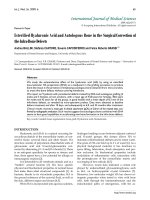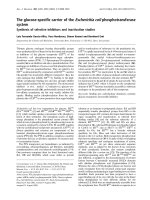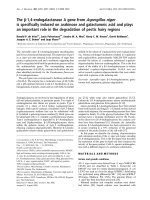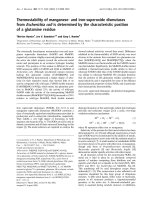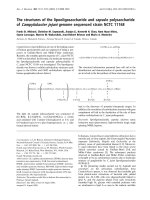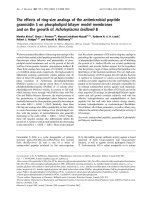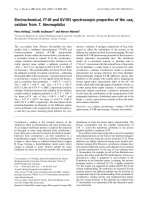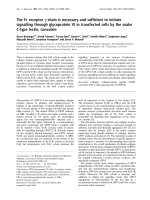Báo cáo y học: " The South London and Maudsley NHS Foundation Trust Biomedical Research Centre (SLAM BRC) case register: development and descriptive data" potx
Bạn đang xem bản rút gọn của tài liệu. Xem và tải ngay bản đầy đủ của tài liệu tại đây (320.56 KB, 12 trang )
BioMed Central
Page 1 of 12
(page number not for citation purposes)
BMC Psychiatry
Open Access
Correspondence
The South London and Maudsley NHS Foundation Trust
Biomedical Research Centre (SLAM BRC) case register:
development and descriptive data
Robert Stewart*
1
, Mishael Soremekun
1
, Gayan Perera
1
,
Matthew Broadbent
1,2
, Felicity Callard
1
, Mike Denis
2
, Matthew Hotopf
1
,
Graham Thornicroft
1
and Simon Lovestone
1
Address:
1
King's College London (Institute of Psychiatry), London, UK and
2
South London and Maudsley NHS Foundation Trust, London, UK
Email: Robert Stewart* - ; Mishael Soremekun - ; Gayan Perera - ;
Matthew Broadbent - ; Felicity Callard - ; Mike Denis - ;
Matthew Hotopf - ; Graham Thornicroft - ;
Simon Lovestone -
* Corresponding author
Abstract
Background: Case registers have been used extensively in mental health research. Recent
developments in electronic medical records, and in computer software to search and analyse these
in anonymised format, have the potential to revolutionise this research tool.
Methods: We describe the development of the South London and Maudsley NHS Foundation
Trust (SLAM) Biomedical Research Centre (BRC) Case Register Interactive Search tool (CRIS)
which allows research-accessible datasets to be derived from SLAM, the largest provider of
secondary mental healthcare in Europe. All clinical data, including free text, are available for analysis
in the form of anonymised datasets. Development involved both the building of the system and
setting in place the necessary security (with both functional and procedural elements).
Results: Descriptive data are presented for the Register database as of October 2008. The
database at that point included 122,440 cases, 35,396 of whom were receiving active case
management under the Care Programme Approach. In terms of gender and ethnicity, the database
was reasonably representative of the source population. The most common assigned primary
diagnoses were within the ICD mood disorders (n = 12,756) category followed by schizophrenia
and related disorders (8158), substance misuse (7749), neuroses (7105) and organic disorders
(6414).
Conclusion: The SLAM BRC Case Register represents a 'new generation' of this research design,
built on a long-running system of fully electronic clinical records and allowing in-depth secondary
analysis of both numerical, string and free text data, whilst preserving anonymity through technical
and procedural safeguards.
Published: 12 August 2009
BMC Psychiatry 2009, 9:51 doi:10.1186/1471-244X-9-51
Received: 10 March 2009
Accepted: 12 August 2009
This article is available from: />© 2009 Stewart et al; licensee BioMed Central Ltd.
This is an Open Access article distributed under the terms of the Creative Commons Attribution License ( />),
which permits unrestricted use, distribution, and reproduction in any medium, provided the original work is properly cited.
BMC Psychiatry 2009, 9:51 />Page 2 of 12
(page number not for citation purposes)
Introduction
Case registers have distinct advantages in their ability to
provide information on specific disorders that is readily
obtainable and available for meaningful analysis. Particu-
lar indications for a case register approach are when the
disorders in question are rare (i.e. cannot be practically
screened for in community populations) and 'high pene-
trance' (i.e. secondary care samples can be assumed to be
representative of total community cases). As with other
epidemiological research methods, their focus is on inves-
tigating the determinants of health states in specified pop-
ulations. Distinct features are that the 'specified
populations' all have a given disorder or level of service
contact, and the 'health states' most often concern the
presentation, features, course and outcome of a given dis-
order rather than risk of the disorder per se. As the 'data
collection' is systematic and prospective, case registers are
able to produce a powerful, longitudinal and comprehen-
sive impression of treated morbidity in any distinctive
region. Perhaps the broadest definition of a psychiatric
case register is that it is 'a patient-centred longitudinal
record of contacts with a defined set of psychiatric services
originating from a defined population' [1]. In a UK con-
text, greater health service evaluation, increased research
into the effectiveness of individual- and service-level inter-
ventions, and analyses of pharmaco-epidemiological
data, are integral to the government's Connecting for
Health Research Capability Programme
nectingforhealth.nhs.uk/systemsandservices/research.
Within mental health, this has created an imperative for
case registers that will be able to meet these goals.
Historically, medical records of some kind have always
been kept and, in keeping with the tradition of careful
methodical scientific observation, these have frequently
been developed into disease registers, through which the
incidence, course and health service use of specified dis-
eases can be monitored and investigated. In the context of
changing social, political, professional and technological
factors, a large number of psychiatric registers were con-
structed throughout the 20
th
century. However, owing to
the expense of maintenance (often carried out manually),
the limited information available (relying on data sheets
completed by clinicians in addition to their routine work-
load), the practical difficulties in monitoring data quality
and limited funding, many programmes closed in the mid
to late 1980s and only a few international registers still
exist.
Rapid technological advances and other developments
over the last decade have led to new possibilities for case
register development. With electronic clinical records
increasingly complementing handwritten notes, large vol-
umes of clinical information are contained in an elec-
tronic format. Because of this, there are now national case
registers worldwide in Israel, Denmark and New Zealand
which cover populations from approximately four to six
million [2-4]. Whilst national registers are valuable, in
that they provide inclusive data on a very large scale, they
are most commonly restricted to hospitalised patients
[2,3] (except the Danish register which now includes out-
patient data [4]). Regional registers in Europe such as the
Verona psychiatric case register which covers a population
of 80,800 [5] and the Groningen psychiatric case register
in the Netherlands which covers a region of approxi-
mately 460,000 [6] are more likely to suffer with prob-
lems due to internal migration (the numbers of which
tend to be higher than migration levels on a national
level), but their strength lies in their ability to cover all
types of psychiatric services within that area, thereby pro-
viding a more comprehensive picture of mental health
than afforded by national registers. However, to our
knowledge, no case register to date has attempted to cap-
ture data from the full clinical record, something which
has only become feasible recently with the advent of fully
electronic medical records systems.
As medical records become increasingly electronic in
nature, the possibility for case registers collected as part of
routine health care has therefore become a tangible possi-
bility. However, there remain several significant hurdles
to overcome. First, the datasets involved are not in a form
accessible to researchers or the statistical programs with
which they are most familiar and a high level of technical
expertise would be required for even the simplest analysis.
Second, a large amount of potentially the most valuable
information is contained within free text rather than in
checkbox format. Third, there are important concerns
about data protection and both technical and procedural
issues to consider in generating data which is adequately
anonymised at the point of analysis – particularly
demanding where free text analysis is envisaged.
In this manuscript we describe the development of a large
regional case register which potentially provides a tem-
plate for addressing these challenges. With records of over
120,000 individual cases representing the total secondary
care use of mental health services for a population of 1.1
million, we believe that the recently developed SLAM BRC
Case Register is the largest regional register in Europe. The
emergence of this psychiatric case register is the result of a
collaboration between the South London and Maudsley
NHS Foundation Trust and the Institute of Psychiatry at
King's College London, and was made possible through a
specialist mental health Biomedical Research Centre
(BRC) award to the two organisations from the UK gov-
ernment's National Institute for Health Research (NIHR).
The development of the case register has paid as close
attention to the issues surrounding privacy and security as
to the technical challenges and, throughout, has followed
BMC Psychiatry 2009, 9:51 />Page 3 of 12
(page number not for citation purposes)
the principle of 'consent or anonymise'. This principle fol-
lows UK case law interpretation of the European Data
Directive (the 'Source Informatics' ruling) which estab-
lishes that the use of data for purposes other than that for
which it was created does not require consent by the pro-
viders of the data, provided that the data are anonymous
[7].
Methods
The South London and Maudsley NHS Foundation Trust
The South London and Maudsley Foundation NHS Trust
(SLAM), whose case records provide the source data for
the SLAM BRC Case Register, is, to the best of our knowl-
edge, the largest mental health care provider in Europe,
serving an aggregate population of 1.1 million over four
London boroughs (Croydon, Lambeth, Lewisham, South-
wark) as well as providing a number of specialist national
services. Descriptive data for the four boroughs from the
national census in 2001 are summarised in Table 1 and
compared with those for London and England. Compared
with England as a whole, London contains a higher pro-
portion of young adults and lower proportions of middle
aged and older adults, with larger proportions reporting
higher education levels and higher status occupations.
People from minority ethnic groups also form substan-
tially higher proportions of the population in London
compared to England. The SLAM catchment boroughs do
not differ substantially from London as a whole in terms
of age, gender, education and socioeconomic status. Over-
all proportions from minority ethnic groups are similar to
London as a whole but the composition is different, with
higher proportions with self-assigned Black ethnicity and
lower proportions Asian. All four boroughs show simi-
Table 1: Descriptive statistics (2001 Census data) for the four London boroughs served by SLAM and comparisons with London and
England statistics
Borough London England
Lambeth Croydon Lewisham Southwark
Total population 266,169 330,587 248,922 244,866 7,172,091 49,138,831
Age (%)
0–19 23.3 26.8 25.7 24.8 24.9 25.1
20–29 22.2 13.3 17.1 19.6 17.0 12.7
30–44 29.2 25.1 28.2 28.3 25.7 22.6
45–74 21.1 28.7 23.7 22.5 26.5 32.1
75+ 4.2 6.1 5.3 4.8 5.9 7.5
Gender (%)
Male 49.3 48.1 48.2 48.9 48.4 48.7
Female 50.7 51.9 51.8 51.1 51.6 51.3
Education* (%)
No qualifications 20.1 22.9 24.2 24.4 23.7 28.9
Level 2 (5 or more GCSEs at A-C) 14.0 21.4 17.4 14.6 17.1 19.4
Level 3 (2 or more A levels) 9.8 9.3 9.1 10.0 9.8 8.3
Level 4/5 (First degree or higher) 40.9 23.6 29.4 34.8 31.0 19.9
Self-assigned ethnicity (%)
White 62.4 70.2 65.9 63.0 67.5 90.9
Mixed 4.8 3.7 4.2 3.7 3.6 1.3
Asian or Asian British 4.6 11.3 3.8 4.1 13.6 4.6
Black or Black British 25.8 13.3 23.4 25.9 12.3 2.3
Other 2.5 1.5 2.7 3.3 3.0 0.9
Socio-economic status* (%)
High managerial/professional 14.0 10.1 9.8 11.7 12.1 8.6
Lower managerial/intermediate 34.1 36.0 33.6 29.3 32.5 28.2
Small employers/lower supervisory 9.8 12.6 11.2 9.9 11.4 14.1
Routine/semi-routine jobs 14.6 15.3 16.2 16.3 14.8 20.7
Never worked/unemployed 6.9 4.7 6.5 7.2 6.0 3.7
Full time students 9.2 6.8 9.4 12.6 9.0 7.0
Migration from mid-2006 to mid-2007
(approximates in thousands)
Inflow 23.5 18.7 18.4 19.8 167.0 511.0**
Outflow 28.9 20.9 21.1 24.1 284.4 299.0**
Balance -5.5 -2.3 -2.8 -4.3 -81.5 +212.0**
*Data restricted to persons aged 16–74 years
**2007 data
BMC Psychiatry 2009, 9:51 />Page 4 of 12
(page number not for citation purposes)
larly high levels of population mobility, together account-
ing for approximately one fifth of that of London overall.
SLAM provides one of the most extensive portfolios of
mental health services in the UK. It supplies a wide range
of multidisciplinary and integrated specialist services
across General Adult, Child and Adolescent, Forensic,
Older Adults, Learning Disabilities and Addiction sections
with close to 4500 members of staff. Numbers of active
and inactive cases within specified directorates are dis-
played in Table 2.
The Trust includes the Maudsley and Bethlem Royal Hos-
pitals whose roles in mental health service developments
have been substantial and longstanding, the Bethlem
Hospital dating as far back as 1247. Its medical school,
founded in the early 1900s, and now known as the Insti-
tute of Psychiatry at King's College London, is a leading
international centre for mental health research and teach-
ing. SLAM has championed the use of electronic medical
records (EMR) for almost a decade and clinical services are
now effectively paperless. Our challenge was to create a
research interface that would interrogate the data availa-
ble and that could return datasets appropriate for research
use and effectively anonymised at the research interface.
The Patient Journey System
The SLAM Patient Journey System (PJS) is a bespoke, sin-
gle, integrated electronic clinical record used across all
Trust services. It was designed primarily to support the
recording and sharing of clinical information, whilst pro-
ducing relevant management and national reports as a
natural by-product. PJS was implemented in SLAM
between October 2005 to October 2006, replacing a
number of independent clinical and administrative infor-
mation systems used in the Trust at the time, including
hard copy case notes, a community-based electronic clin-
ical record and Care Programme Approach system, two
separate inpatient Patient Administration Systems (PAS),
and Adult Mental Health and Addictions service adminis-
trative systems. At implementation, all patient-based
information for patients seen from 1999 onwards was
migrated into PJS from electronic legacy systems.
PJS is a comprehensive record of all clinical information
recorded throughout patients' journeys through Trust
services, including demographic and contact information,
dates and other details of referrals and transfers, detailed
clinical assessments, care plans and medication, clinical
activity and reviews. Imaging and laboratory data are not,
to date, recorded here. The record is used and maintained
by multi-disciplinary professionals and consists of both
structured data (such as dates, integers and pick-lists) and
unstructured free text (including written assessments,
progress notes and correspondence). PJS includes specific
assessments such as structured physical health assess-
ments, cognitive function (MMSE), and outcome meas-
ures such as the Health of the Nation Outcome Scales.
The SLAM BRC Case Register Interactive Search (CRIS)
In terms of core functionality, the CRIS system allows
researchers to search against any combination of struc-
tured fields (date, numerical etc.) and unstructured fields
(user-defined text strings) from PJS records. The tool 'hits'
relevant records based on search terms (such as a particu-
lar coded diagnosis and/or a particular text string in a clin-
ical assessment). Users then specify the precise fields they
want returned, which may be the same as or different
from those they searched against. Results are returned in
spreadsheet format and are exportable as CSV files for fur-
ther analysis. An example of a search return is displayed in
Figure 1.
In terms of technical architecture, CRIS was built in part-
nership with BearingPoint™ and uses FAST™ search tech-
nology. Source PJS clinical information is currently held
in Lotus Notes. To build the FAST searchable index these
data need to be converted to xml. A bespoke device
termed the 'xml. aggregator' was created to pull Notes data
from PJS and construct an xml. copy. During the construc-
Table 2: Summary statistics active and inactive cases by Directorate within SLAM (Nov 2008)
Directorate Number
Active Inactive† Total
Child and Adolescent Mental Health Services 5857 11,452 17,309
Adult Mental Health 14,932 58,462 73,394
Mental Health of Older Adults 3502 9948 13,450
Forensic 661 378 1039
Addictions 4151 4691 8842
Learning Disabilities 954 841 1795
Specialist national services 5439 5031 10,470
Total 35,496 90,803 126,299
†Inactive: those not currently receiving treatment and who have been discharged from all services
BMC Psychiatry 2009, 9:51 />Page 5 of 12
(page number not for citation purposes)
tion process the xml. aggregator also reconstructs a family
hierarchy for each record, including all the documents
and fields in the record, and cleans out exceptional data
anomalies, such as incorrectly formatted data. Once the
cleaned xml. version of PJS has been created the data pass
through the FAST pipeline stages, which have been config-
ured to meet the anonymisation requirements. At record
level, any combinations that match entries in structured
name, date of birth and address fields in PJS are masked
(replaced with ZZZZZ, as displayed in Figure 1) in the
searchable index. In addition, an anonymised BRC identi-
fier is constructed from the service user's NHS number,
which is then excluded from the searchable index. NHS
numbers are unique to all individuals in the UK and are
the primary identifier for all state provided healthcare
(both primary and secondary care). They therefore pro-
vided the logical solution for avoiding patient duplication
and as a source for a unique identifier that will link poten-
tially multiple care episodes. The algorithm for creating
BRC identifiers from NHS number is hidden and cannot
be accessed by front line researchers. A Java front-end ena-
bles users to construct search queries, which are converted
to FAST Query Language (FQL) to interrogate the index.
The technical architecture behind the CRIS system is sum-
marised in Figure 2.
The security model
The development of CRIS demanded that due attention
be given to legal and ethical considerations attendant
upon the use of confidential health data. The IOP/SLAM
BRC Stakeholder Participation Theme took a central role
here, given that its remit is to ensure that the participation
of two key stakeholder groups, service users and carers
(along with other groups who are frequently under-repre-
sented in research on grounds of gender, age, culture and
ethnicity), are at the heart of the BRC's research work. A
member of the Stakeholder Participation Theme, herself a
mental health service user, chaired a time-limited working
group that developed security and confidentiality proce-
dures for the case register (this group also included the
Trust Caldicott Guardian [the senior person in UK NHS
Trusts responsible for protecting the confidentiality of
Screen shot of CRIS results tableFigure 1
Screen shot of CRIS results table.
x Step 1: Records were searched for the terms
‘CBT’ and ‘Psychosis’ entered into free text case
notes.
x Step 2: Ethnic category, sex, the date of relevant
events and the text of the case themselves were
brought back in the results table
.
BMC Psychiatry 2009, 9:51 />Page 6 of 12
(page number not for citation purposes)
patient and service-user information and enabling appro-
priate information sharing], the ex-chair of a Research
Ethics Committee, and the child protection lead within
the Trust).
Deliberation over how to develop both technical and pro-
cedural frameworks that would adequately address the
legal and ethical issues raised by the case register took
place in the context of lively discussion at a national level
over the use of confidential health data. There is growing
recognition, both within England and internationally, of
the importance and urgency of establishing robust poli-
cies, standards and best practices governing the sharing of
data in general, and the secondary use of anonymised
health data in particular [8].
While recent consultations in the UK [9] have indicated
that members of the public in principle approve of the use
of databases for biomedical research, they have also indi-
cated that the public wishes to know more about the
research process, why certain data are required, how they
are stored and interpreted, and who has access to them. In
addition, these consultations have pointed to some con-
cerns about the use of 'sensitive' data – including those
relating to mental health diagnoses – that carry the poten-
tial for stigmatisation. However, relatively little is cur-
rently known about what those with psychiatric,
neurodegenerative and/or substance use diagnoses them-
selves think about research databases comprising clinical
data [10]. In light of this national context, it was clear that
developing frameworks to ensure the ethical and secure
use of CRIS demanded a focus on three distinct, though
overlapping domains:
1. Technical measures How ought the technical (i.e.
programming) components of the case register best be
designed to protect the confidentiality and anonymity
of clinical data?
2. Procedural measures: Which procedures and
mechanisms are necessary to regulate access to and use
of the case register, and to ensure that governance of
CRIS technical architectureFigure 2
CRIS technical architecture.
Pipeline stages
PJS
Clinical
Database
XML.
Aggregator
THE CASE REGISTER
Application
Server
RESEARCHER
FAST
Index
SLAMFIREWALL
NHS No /
BRC ID
SQL
database
BMC Psychiatry 2009, 9:51 />Page 7 of 12
(page number not for citation purposes)
the register gains and maintains the trust of stakehold-
ers?
3. Engagement with stakeholders How best to engage
stakeholders (who include service users, carers, health
professionals, service support staff, as well as members
of the public) in discussions about the case register's
contributions to mental health research, and to dis-
seminate information regarding the case register to
service users and their carers/families?
A summary of the mechanisms and procedures that were
developed to respond to the challenges raised in each of
these three domains follows.
1. Technical measures
It was critical to develop robust measures to ensure that
important epidemiological data are included in CRIS (e.g.
age, gender, ethnicity, broad locality of residence) without
compromising the anonymity of service users and of car-
ers/family members. Various data are therefore truncated
(e.g. only the first half of the UK postcode, and only the
month and year of birth are included). One of the key
research strengths of the Case Register – the capacity to
interrogate free text as well as structured data – raises par-
ticular challenges for anonymisation, given the complex-
ity and extent of free text in the clinical database (PJS).
While it is apposite to recall Kalra and colleagues'
reminder that 'it is wise to consider anonymised data as
if there is still some risk of re-identification and disclosure'
[8], all efforts were made when developing CRIS's pro-
gramme architecture to ensure that anonymisation is
robust throughout the entirety of each service user's
record.
2. Procedural measures
Procedural measures were required both in relation to the
initial launch of the Case Register (e.g. mechanisms to
ensure that all data are held securely within the Trust fire-
wall, and to control access to the case register) and as
regards its ongoing use, monitoring and development.
Particular attention has been paid to upholding the scien-
tific rigour of research that interrogates data from the case
register. A committee was formed to provide operational
oversight of the Case Register, as well as to ensure that any
study intending to use the register has scientific value and
has taken precautions to diminish the likelihood of any
searches compromising confidentiality (e.g. by returning
details, from individual or combinations of variables, of
rare and therefore potentially identifiable groups of indi-
viduals). This Oversight Committee reviews all applica-
tions to use the Case Register and also aims to provide
practical advice to researchers on how best to navigate and
manipulate the complex and extensive data.
Ethics approval was sought for the research use of ano-
nymised databases derived using CRIS, and was granted
by an independent Research Ethics Committee ('Oxford-
shire C') that is 'flagged' to indicate expertise in research
databases. The security model (that comprises both tech-
nical and procedural elements) was approved by the Trust
Caldicott Guardian and signed off by the Trust Executive
who are also responsible for research governance and to
whom the Oversight Committee reports. The Oversight
Committee is therefore responsible for considering
projects using the Case Register for secondary analysis of
anonymised data and ensuring that these are compliant
with approval criteria as well as being an appropriate use
of the data. The Committee is chaired by a mental health
service user and member of the SLAM BRC Stakeholder
Participation theme, and the Committee has representa-
tion from the SLAM Research Ethics Committee, the
SLAM Caldicott Guardian, and the SLAM BRC Child and
Adolescent Mental Health research theme, in addition to
the Case Register Academic Lead and Case Register Project
Manager. Researchers wishing to use the Case Register are
required to submit a Project Approval Form which asks for
a summary of the purpose of the proposed project and the
nature of the data required for analysis (so that searches
can be audited). No cost is levied for use of the database.
This manuscript focuses on the use of the Case Register for
research purposes. However, it is also important to point
out that it is also used for Trust audits (i.e. to facilitate
projects approved by statutory audit committees). As well
as the functions mentioned above, the Oversight Com-
mittee is responsible for checking that proposed audits
have received appropriate approval and to ensure that
there is no unauthorised or unprincipled use including
that of data identifying staff members (which are not ano-
nymised).
3. Engagement with stakeholders
A communications plan has been developed to inform the
whole Trust community (service users, carers, clinicians
and other Trust staff) about the existence, potential bene-
fits and proposed uses of the Case Register. This plan will
respond to the findings of the recent consultations about
medical research databases cited above through specifi-
cally discussing how health research proceeds, why certain
data are required, and how they are stored and analysed.
The plan has been shaped through consultation with the
BRC's service user advisory group. In addition, the Stake-
holder Participation Theme of the BRC is interrogating the
ethical, societal and practical issues raised by the increased
focus on electronic medical records. This research will
inform the ongoing development of the case register and
contribute to wider discussions concerning secondary
uses of health data. The Appendix summarises the mech-
anisms and procedures that have been developed to
BMC Psychiatry 2009, 9:51 />Page 8 of 12
(page number not for citation purposes)
address the legal and ethical issues pertaining to the use of
confidential health data within the case register. Finally,
although under UK law consent is not required for use of
anonymised information, the Case Register has the tech-
nical capacity to allow opt out by anyone who objects to
their data being used for research purposes (i.e. rendering
their clinical data inaccessible to the search functions).
This option is available in the Case Register. The role of
the Oversight Committee includes ensuring that the use of
anonymised clinical data for research is widely publicised
among service users, carers and Trust staff, involving an
ongoing information dissemination plan using different
media including Trust information leaflets, public meet-
ings and websites.
Results
Summary statistics
Table 3 shows summary statistics of the SLAM BRC Case
Register from a search carried out in October 2008. The
largest age group of cases lies within the 20 to 40 year age
range. There are also approximately equal numbers of
males and females represented in the register. The distri-
bution of ethnic groups is broadly consistent with Census
distributions in the boroughs served with only marginally
fewer identifying themselves as other than British. How-
ever, it should be borne in mind that, while both the Cen-
sus and NHS records aim to collect self-assigned ethnicity,
the lists of available categories are different; the two are
not therefore directly comparable. The present number of
active patients (defined as those who have an active Care
Programme Approach on the Register), is approximately
35,000.
Diagnoses
A description of numbers of cases by primary (ICD-10)
diagnosis, again from a search in October 2008, is pro-
vided in Table 4 for the 65% of all cases where this infor-
mation was available. In SLAM, diagnoses are generally
assigned by members of the clinical team primarily
responsible for the patient concerned with team discus-
sion as required. A choice is made from a full list of ICD
codes appearing in a checkbox on PJS, and proportions of
cases with an assigned diagnosis has been a key factor
monitored by the Trust and its funders for the last 2–3
years. Multiple diagnoses may be recorded but, for sim-
plicity, only data on primary diagnoses are displayed here.
Of mental disorder diagnoses, the most commonly
assigned are mood disorders followed by schizophrenia
and related disorders, substance misuse, neuroses and
organic disorders.
Patient referral and discharge
Figure 3 illustrates data on referrals and discharges by year
for SLAM patients. The number of patients that had been
referred at least once over the period January 2008 until
20
th
Oct 2008 was 25,077. Over the same period, the
number of those that were discharged at least once from
SLaM services was 22,538. The rise in numbers of those
referred and discharged over the years is more likely to
represent the growth in the use of electronic records, than
actual increases in referrals and discharges. Patients are
not removed from the register when discharged but no
further record of their activities is kept until they access
services.
Discussion
The psychiatric case register presents a multitude of
research and service development possibilities, from gen-
eration of descriptive data on mental disorder prevalence
or service case mix, to applications as a case-finding tool
for trials and surveys. Groups of patients that share social,
demographic, clinical or environmental characteristics, or
any combination of these, can be followed up as a cohort
in order to investigate risk factors, outcomes and survival.
Table 3: Descriptive summary of SLAM case register records*
Number (%)
Total 122,440
Age (years)
≤ 20 20,274 (16.6)
21–40 43,610 (35.6)
41–60 36,305 (29.7)
61–80 12,881 (10.5)
>80 yrs 9370 (7.7)
Gender
Male 60,833 (49.8)
Female 61,342 (50.2)
Self-assigned ethnicity (full breakdown)**
British 43,909 (57.8)
Irish 2343 (3.0)
Any other White background 6653 (8.6)
Mixed: White and Black African 354 (0.5)
Mixed: White and Asian 254 (0.3)
Mixed: Any other mixed background 418 (0.5)
Indian 1041 (1.3)
Pakistani 420 (0.5)
Bangladeshi 355 (0.5)
Any other Asian background 1483 (1.9)
Caribbean 5260 (6.8)
African 5360 (6.9)
Any other Black background 6236 (8.0)
Chinese 190 (0.2)
Any other ethnic group 3398 (4.4)
Self-assigned ethnicity (amalgamated)**
British 52,905 (68.1)
Mixed 1026 (1.3)
Indian, Pakistani, Bangladeshi or 'other Asian' 3299 (4.2)
Caribbean, African or any 'other Black' 16,856 (21.7)
Other 3588 (4.6)
Number with active Care Programme Approach*** 35,396 (28.9)
*Data ascertained on 20/10/08
**Recorded for 77,674 (63.4%)
***Implying active care management and ongoing service contact
BMC Psychiatry 2009, 9:51 />Page 9 of 12
(page number not for citation purposes)
Table 4: Descriptive data on recorded primary diagnoses in the SLAM case register
Assigned primary diagnosis (ICD-10 code and description) Number (%)*
F0–F09 – Organic, including symptomatic, mental disorders 6414 (8.0)
F10–F19 – Mental and Behavioural disorders due to psychoactive substance use 7749 (9.7)
F20–F29 – Schizophrenia, schizotypal and delusional disorders 8158 (10.2)
F30–F39 – Mood (affective) disorders 12,756 (16.0)
F40–F48 – Neurotic, stress-related and somatoform disorders 7105 (8.9)
F50–F59 – Behavioural syndromes associated with physiological disturbances and physical factors 1504 (1.9)
F60–F69 – Disorders of adult personality and behaviour 1291 (1.6)
F70–F79 – Mental Retardation 942 (1.2)
F80–F89 – Disorders of psychological development 1541 (1.9)
F90–F98 – Behavioural and emotional disorders with onset usually occurring in childhood and adolescence 3796 (4.8)
F99 – Unspecified mental disorder 4570 (5.7)
No Axis 1 diagnosis 4507 (5.6)
G – Diseases of the nervous system 304 (0.4)
Other illness codes (A-E, H-Q) 216 (0.3)
R – Symptoms, signs and abnormal clinical and laboratory findings, not elsewhere classified 231 (0.3)
S-Y – Injury, poisoning and external causes 103 (0.1)
Z – Factors influencing health status and contact with health services 18,704 (23.4)
*Total cases with primary diagnosis recorded 79,891
Graph illustrating those recorded in the case register, to have been referred to or discharged at least once each year from SLAM servicesFigure 3
Graph illustrating those recorded in the case register, to have been referred to or discharged at least once
each year from SLAM services.
0
5,000
10,000
15,000
20,000
25,000
30,000
35,000
200020012002200320042005200620072008
(1 Jan
- 20
Oct)
Year
No. of patients
Numbers referred
Numbers discharged
BMC Psychiatry 2009, 9:51 />Page 10 of 12
(page number not for citation purposes)
As stated earlier, the key benefits of cohort studies using
case register data are in ascertaining outcomes (e.g. per-
sistence/recovery) in people with specific disorders, in
contrast to conventional epidemiological cohort studies,
which focus primarily on incidence of disorders in previ-
ously unaffected populations. The case register has both
prospective and retrospective capabilities and is also the
most appropriate tool to use in studying patterns of care,
providing invaluable information for evaluating/auditing
and planning services, as well as monitoring service use.
In addition, the richness of free text data opens up diverse
qualitative research possibilities (e.g. analyses of changing
practices of medical case note keeping, or of how particu-
lar symptoms – e.g. hallucinations – are inflected by cul-
ture, age and/or gender).
The SLAM BRC Case Register is a more evolved entity than
its predecessors in that it automatically updates informa-
tion and maintains itself, avoiding substantial costs in
time and resources. It also automatically cleans data by
analysing records against patient name, date of birth and
NHS number to ensure there are no duplicated records, a
problem that older registers struggled to resolve. Unlike
previous registers, the SLAM BRC Case Register has, in the-
ory, an unlimited scaleable capacity. A further advantage
is that, in the UK context, in contrast to most other
nations, the vast majority of mental healthcare is provided
by specific state-run services with minimal use of privately
funded care. In this respect, SLAM has a near 100% clini-
cal coverage in its four boroughs, which allows reasonable
estimation of the total population 'at risk' from UK Cen-
sus statistics. Missing people in numerator samples will be
principally those choosing to access or purchase mental
healthcare elsewhere. Although we are not aware of any
local data enumerating this, in a UK context it is quite rare
although clearly associated with income levels and a
potential source of bias. As with all case registers, there are
problems in the stability of diagnoses which, clinically,
are subject to change based on varying presenting symp-
toms. Because changes on the PJS source database auto-
matically create an archive of the original data, the BRC
case register allows the researcher to view the history of
diagnoses a particular patient has been given since first
presentation. This enables investigation into this clinical
artefact, similar to that carried out by Munk-Jorgensen
and colleagues [11].
Key limitations in the case register approach are that the
data available, and their quality, depend upon clinicians'
accuracy and timeliness in reporting of clinical informa-
tion. This is particularly pertinent to the SLAM BRC Case
Register, which draws data directly from routine adminis-
trative and clinical sources (rather than the older genera-
tion of registers which have been more involved in the
collection and cleaning of incoming data). Limitations on
any research based around clinical services are that the
availability of resources within certain areas, and cultural
attitudes to using services, will affect the rate at which peo-
ple access services and therefore are represented in the
dataset. Case register information is limited to people
who have sought help and have accessed services and does
not include undiagnosed mentally ill individuals within
the community. All of these issues point to the impor-
tance of close liaison between researchers using the case
register and members of clinical teams who will have
more familiarity in the quality of individual variables, as
well as a sense of the penetrance of a given disorder and
the likely representativeness of those known to clinical
services. The intention of the SLAM BRC is to put in place
structures and working practices which facilitate this liai-
son.
We believe that the SLAM BRC Case Register described
here represents a 'new generation' of this research tool,
drawing on very recent developments primarily in com-
puter science and information technology but also set in
the context of current debate around complex issues of
autonomy, data protection and participation in health
research. While the Register is now operational, a number
of further developments are envisaged, particularly
involving links with other databases, both within the
Trust and BRC (such as, with consent, research project
data and large neuroimaging and 'omics [genomics, pro-
teomics, transcriptomics etc.] data resources) and, subject
to appropriate approvals, external sources (such as small
area level census statistics, primary care provider data,
national mortality data). In theory, the Register could be
used in the future for identifying potential research partic-
ipants, and we are currently exploring the ethical and legal
frameworks relating to this, as well as the opinions of serv-
ice users.
Conclusion
We describe the development of a psychiatric case register
built around the fully electronic records of Europe's larg-
est provider of secondary mental health care. Develop-
ments described include technical procedures and the
security model. Key features of the SLAM BRC Register
include the capacity to search and extract anonymised
data including free text fields. We believe that the princi-
ples underlying this development are likely to be widely
applicable and should revolutionise the capacity of one of
psychiatry's oldest research methods.
Abbreviations
SLAM: South London and Maudsley NHS Foundation
Trust; IOP: Institute of Psychiatry (King's College Lon-
don); BRC: Biomedical Research Centre; NHS: UK
National Health Service; PJS: Patient Journey System;
NIHR: UK Government National Institute for Health
BMC Psychiatry 2009, 9:51 />Page 11 of 12
(page number not for citation purposes)
Research; PAS: Patient Administration System; MMSE:
Mini-Mental State Examination; HoNOS: Health of the
Nation Outcome Scales; CRIS: Case Register Interactive
Search; ICD: International Classification of Diseases.
Competing interests
All authors have either substantive or honorary contracts
with the South London & Maudsley NHS Foundation
Trust which owns the rights to the CRIS system described
and stands to gain financially from any wider application.
Authors' contributions
Analyses were carried out by MB and MS. The manuscript
was finalised by RS and MS with substantial text contribu-
tions from MB, GP and FC, and further comments and sig-
nificant input from all remaining co-authors who also
oversaw the planning and development of the SLAM BRC
Case Register.
Appendix
CRIS security model
Technical measures
1. Fields dedicated to recording personal identifiable
information (PII) in the clinical database (PJS) cannot
be directly searched in the case register (these include
NHS number, Trust ID, name, address and other con-
tact details, date of birth, and any stated contacts (e.g.
relative's name and address)). The month and year of
birth remain; postcode is truncated to the first three
postcode digits/letters; ethnic groups are amalgamated
so that rare groups do not act as identifiers.
2. The unique identifier used on the database is
derived from each service user's NHS number by CRIS
using an encryption process not accessible to research-
ers.
3. Free-text is anonymised: service users' and carers' PII
that is entered within dedicated fields in PJS is then
masked ('ZZZZ-ed out') every time that it appears in
free-text entries.
4. All searches within CRIS are recorded and made
available for audit by a CRIS administrator to monitor
compliance with the security protocol.
Procedural measures
1. All CRIS users must have honorary contracts with
the NHS Trust, carrying a duty of confidentiality
should any potentially identifiable information be
encountered by mistake. This contract necessitates an
enhanced CRB check.
2. All CRIS users must sign electronically a confidenti-
ality agreement whenever they log on (using unique
Trust usernames and passwords).
3. The CRIS application and all data exported from
CRIS are held within the Trust firewall, ensuring that
these data are subject to the same rigorous security –
both technical and policy-related – already in place for
Trust identifiable electronic information.
4. A Research Governance Committee provides opera-
tional oversight and management of CRIS.
5. CRIS has received ethics approval for use as an ano-
nymised database for secondary analysis.
6. CRIS was approved by the Trust Caldicott Commit-
tee and signed off by the Trust executive.
Engagement with stakeholders
1. The stakeholder participation theme of the BRC led
in developing the procedural elements of the security
model.
2. The Research Governance Committee overseeing
CRIS is chaired by a member of the stakeholder partic-
ipation theme (who is herself a mental health service
user).
3. A communications plan has been developed to
inform the entire Trust community (service users, car-
ers, staff) of the existence, potential benefits and pro-
posed uses of CRIS.
4. The BRC service user advisory group was consulted
on the CRIS communications plan, and is regularly
consulted about developments regarding CRIS.
Acknowledgements
The authors acknowledge financial support from the National Institute for
Health Research (NIHR) Specialist Biomedical Research Centre for Mental
Health award to the South London and Maudsley NHS Foundation Trust
and the Institute of Psychiatry, King's College London. The development of
the SLAM BRC Case Register was funded by a Capital Award from the UK
NIHR and is further supported through the BRC Nucleus funded jointly by
the Guy's and St Thomas' Trustees and South London and Maudsley Special
Trustees. All authors also acknowledge funding from the National Institute
for Health Research (NIHR) Specialist Biomedical Research Centre for
Mental Health award to the South London and Maudsley NHS Foundation
Trust and the Institute of Psychiatry, King's College London.
References
1. World Health Organisation: Psychiatric case registers. Report
on a Working Group. Copenhagen: WHO Regional Office for
Europe; 1983.
2. Joyce PR: Changing trends in first admissions and readmis-
sions for mania and schizophrenia in New Zealand, 1974 to
1984. Aus NZ JMed 1987, 21:82-6.
Publish with BioMed Central and every
scientist can read your work free of charge
"BioMed Central will be the most significant development for
disseminating the results of biomedical research in our lifetime."
Sir Paul Nurse, Cancer Research UK
Your research papers will be:
available free of charge to the entire biomedical community
peer reviewed and published immediately upon acceptance
cited in PubMed and archived on PubMed Central
yours — you keep the copyright
Submit your manuscript here:
/>BioMedcentral
BMC Psychiatry 2009, 9:51 />Page 12 of 12
(page number not for citation purposes)
3. Lichtenberg P, Kaplan Z, Grinshpoon A, Feldman D, Nahoon D: The
goals and limitations of Israel's Psychiatric Case Register.
Psychiatric Services 1999, 50:1043-8.
4. Munk-Jorgensen P, Mortensen PB: The Danish PsychiatricCase
Register. Danish Medical Bulletin 1997, 44:82-4.
5. Amaddeo F, Beecham J, Bonizzato P, Fenyo A, Knapp M, Tansella M:
The use of a case register to evaluate the costs of psychiatric
care. Acta Psych Scand 1997, 95:189-98.
6. Pijl YJ, Kluiter H, Wiersma D: Change in Dutch mental health
care: an evaluation. Soc Psychiatry Psychiatr Epidemiol 2000,
35:402-7.
7. Richards T: Court sanctions use of anonymised patientdata.
BMJ 2000, 320(7227):77B.
8. Kalra D, Gertz R, Singleton P, Inskip HM: Confidentiality of per-
sonal health information used for research. BMJ 2006,
333:196-8.
9. Armstrong V, Barnett J, Cooper H, et al.: Public perspectives on
the governance of biomedical research: a qualitative study in
a deliberative context. London: Wellcome Trust; 2007.
10. Callard F, Wykes T: Mental health and perceptions of biomar-
ker research: possible effects on participation. Journal of Men-
tal Health 2008, 17:1-7.
11. Munk-Jorgensen P: The schizophrenia diagnosis in Denmark.
Acta Psych Scand 1985, 72:266-73.
Pre-publication history
The pre-publication history for this paper can be accessed
here:
/>pub
